Jig Fishing For Steelhead: Best Methods Used By River Guides
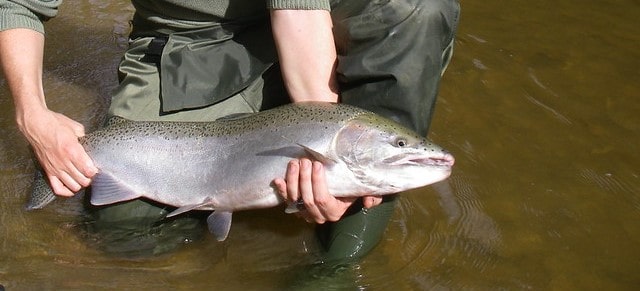
When I pull out jigs on a guide trip, my clients usually look surprised because they don’t think of jigs as the best option for fishing for steelhead. But, the truth is that fishing for steelhead with jigs is very effective if it’s done correctly.
There are a few methods of jig fishing for steelhead, and I have tried and tested many of them over my 30+ years of steelhead fishing. I’ve also had the opportunity to learn from other fishing guides, enabling me to narrow it down to the two most effective methods.
Jigging for steelhead is either done by drifting small lightweight jigs, or micro jigs, under a float, or you can use larger heavier jigs with the twitching method. These steelhead jig fishing methods are very different, and so are the jigs used.
Jig Fishing For Steelhead
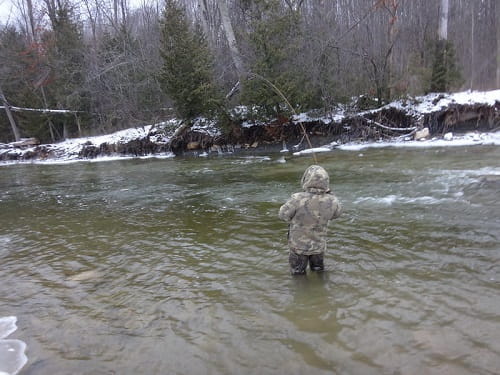
Jigs are not the types of lures or a bait that the steelhead often sees simply because most guys do not use them.
Therefore, when other methods and baits aren’t working well, jigs can be the way to go.
Actually, jigging for steelhead can work almost anytime and anywhere in the river. You can also cover the water fast with jigs, or you can cover the water slowly if needed.
When jigging for steelhead, you also have the option to use very erratic retrieves to entice active steelhead to bite, or you can try slower finesse tactics to entice those less active steelhead to bite.
Anglers are able to use jig fishing for steelhead in any season and any type of water. I know river guides that even use jigs at the mouth of the rivers and on the beach or shorelines close to the river mouths when the steelhead are staging.
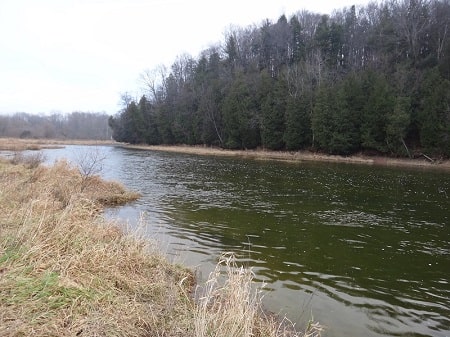
It’s important for an angler to know when, where, and how to fish both methods for maximum results.
As an example, float fishing a jig in 2 feet of water or in small pocket water is not going to work well But, casting the right size and right weight jig into a small pocket can work very well.
Twitching jigs for steelhead can work well almost anywhere in a river, but float fishing jigs for steelhead is usually best done in medium to fast currents at depths of 3 to 12 feet.
How To Jig Fish For Steelhead
There are probably 4 or 5 ways to jig for steelhead, and have tried and tested them all.
I have cast jigs out and slowly dragged them, crawled them, or jiggled them along the bottom in front of inactive steelhead, in the same way that bass anglers would when using a slow presentation for bass.
I’ve also used the old-school method of hopping them up and down off the bottom through deeper, slower pools. This can be very effective if done well. I have also ripped and twitched them high in the after column.
I’ve also drifted jigs under floats with a dead drift method, or with a method that can impart some action to the jig.
Jigging For Steelhead With Floats
The first method, and the one that I do the most is float fishing with jigs. It’s very easy to remove the bait and add a jig in place of the bait.
There have been many times when we’ve fished the crap out of a spot with multiple baits and have either caught everything that was willing to bite those baits, or had no bites, and then before we leave, we run jigs through the spot and have caught multiple steelhead.
I encourage all float anglers to try this. I’ve talked in a previous article on best baits and how to choose baits about something I call rotating baits, and there is no reason why someone shouldn’t do this with a jig.
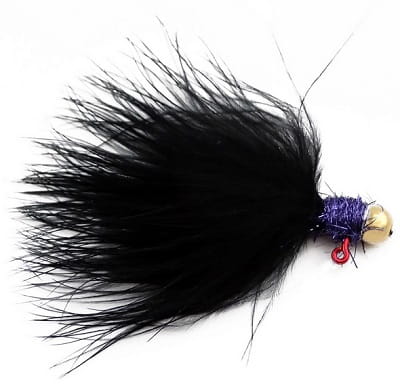
The reason I think jigs can work so well after the fish have already seen a bunch of spawn sacs, beads, worms, or other common baits is that jigs look buggy and they have “movement” or “life” to them, and this can trigger a strike response.
Marabou has even more movement in the current than it does in still water. See underwater footage of how marabou, rabbit and flash move underwater – HERE
When jig fishing for steelhead under a float, the best jigs are smaller 1″ to 3″ jigs that use a feather called marabou.
Marabou is the fluffy black-tailing feather you see in the jig picture. Even a mix of marabou, with tinsel, flash, or rubber or plastic strands can be very effective.
Also, lighter is often better, so 1/16, 1/8, or 1/4 once jigs are usually good. I discuss size more below.
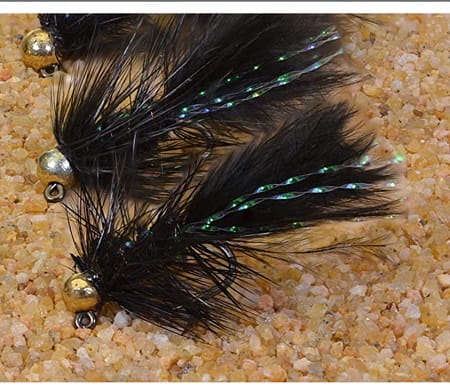
The Jiggy Bugger Steelhead jig or jigs similar to this are an excellent choice under a float. Check them out at FishUSA.com
Another great jig is the Region Fishing Tungsten Micro Wooly Bugger Jig Fly.
You can check them out at Amazon.
For more on jigs for steelhead and a lot more jigs that work well for steelhead, both float jigs, and twitching jigs, check out 11 Best Steelhead Jigs.
Steelhead Jig Fishing Technique: With Floats
To float fish with a jig, you can either fish it like a worm or a spawn sac, which works great in faster-moving currents.
Or you can impart action to the jig by pulling back on the float a foot or two at a time and then releasing. You can continue to pull and release the float throughout the drift to give the jig some action. This will stop-lift-and-drop the jig and can be deadly in slower-moving sections of the river.
You can do this drag-and-release method a little or a lot depending on what the fish want.
Some anglers, myself included, will try to jiggle the float on the surface with a high rod tip and a tight line, this will jiggle the jig below the float and add life to the jig.
Twitching Jigs For Steelhead
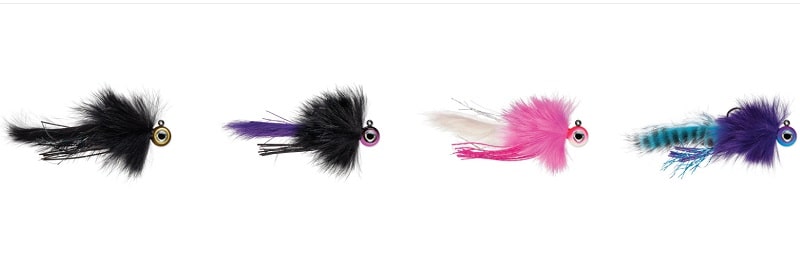
The other primary way to do jig fishing for steelhead is to use a method known as twitching.
When twitching jigs for steelhead, you want to use a steady up-and-down motion, which you can create by lifting and dropping your rod tip.
Simply cast across the river, let it sink to the bottom, and then lift and drop the rod tip 1 to 3 feet. This should, in turn, also lift and drop your jig 1 to 3 feet off the bottom.
Try to maintain a tight line as the jig drops to ensure you feel a biting fish. Dropping your rod tip too fast can put slack in the line between the jig and the rod tip, and this slack can cause you to miss the feel of a bite.
Guide Tip: Do not get too aggressive when twitching a jig because overly aggressive jigs can move too fast for the steelhead to hit it, and you will miss a lot more fish.
The method of twitching jigs for steelhead can be very effective in almost all types of rivers, as well as out at the mouths of rivers and along the shorelines of the Ocean or Great Lakes. You can see this twitching method in this video: Twitching For Coho.
I discuss the best jig sizes and weights below.
Great jigs that I use and recommend for twitching are the SPRO Bucktail Jig, the Northland Buck-A-Roo Jig, and my favorite is the VMC Twitchin’ Jig.
Best Twitching Jigs
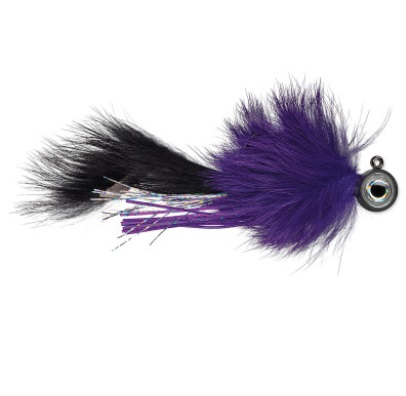
VMC Twitching Jig
There is a lot to like about this twitching jig which is why it’s my favorite.
- Big Eyes
- Sharp wide gap hook
- Rabbit hair and rabbit strip for body thickness, length, and life-like movement.
- Tinsel fibers, flashabou, and living silicone accents
- Lots of great colors
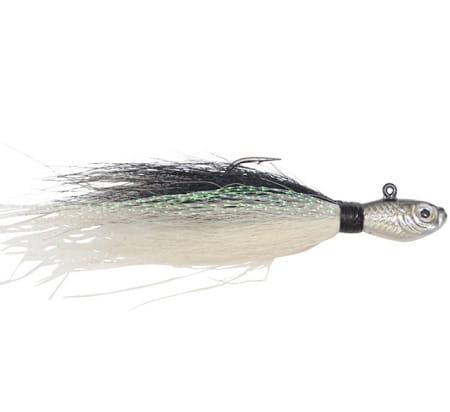
SPRO Bucktail Jig
Another great jig that is one of my favorite twitching jigs for both river and shore.
- made from bucktail for action, body, and length
- Sharp hook with a decent gap
- Lots of great colors and sizes
- Added flash
- Swim head and eye for unique swim action.
- Durable
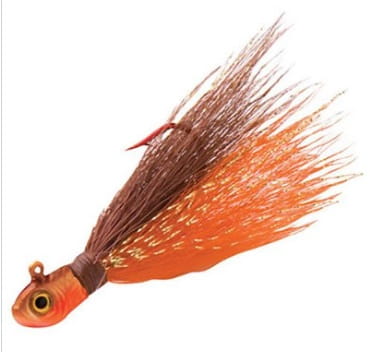
Northland Buck-A-Roo Jig
A twitching jig that is good for steelhead, trout, and salmon fishing.
- Mustad Ultra-Point hooks
- Good thickness and length
- Bucktail with flash for added attraction
- Lots of colors and sizes to choose from
- Large swim head with eyes
- Tip it with a twister tail or paddle tail
For more detailed information on how to do this, check out my page Twitching Jigs For Steelhead.
Jig Tails For Steelhead

Many guides, myself included, will add tails to the above mentioned twitching jigs. A tail could be something simple like A Mad River Paddle Tail Worm, or it could be something like a paddle tail grub, or even a twister tail.
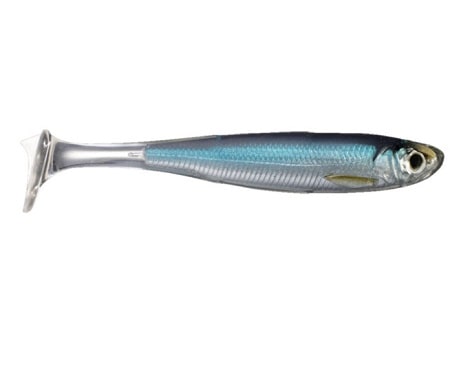
The tail adds volume and length, and action to the jig, which are all good things.
Adding a pink twister tail or paddle tail minnow to a purple and black twitching jig can be deadly, and it’s one of my most effective combinations, but there are other great combinations that can be very good as well.
I discuss jig colors more below.
Gear For Jig Fishing For Steelhead
When float fishing with jigs, any float rod will work, and most anglers and guides will use 11 to 13-foot float rods.
When jigging for steelhead under a float, you can use spinning reels or baitcasting reels, but the best reel for float fishing with jigs is a Centerpin reel. I discuss float fishing and Centerpin fishing on my page Float Fishing: Most Effective Methods River Guides Use.
When twitching jigs for steelhead, most anglers and guides, myself included, recommend spinning reels in the 30 to 40 size paired with a 7-foot to 8-foot spinning rod or a baitcasting rod that is a medium or medium heavy, and I prefer moderate fast to fast action rods with a faster tip.
Good Steelhead Jig Rods To Consider: For Twitching Jigs
You could jig fish for steelhead with just about any decent 6 or 7-foot freshwater fishing rod; however when fishing in rivers, and due to the size and strength of the steelhead, I prefer slightly longer rods than you would see a bass or walleye anglers using, and a rod that is slightly heavier to handle those big steelhead.
The longer rod will help keep the line off the rocks when a steelhead bolts far up or down through shallow rapids, and the extra length will aid in casting distance and may protect lighter leaders and lines.
Spinning Rods:
- Okuma SST New Generation Spinning Rod: 7’6 Medium Heavy -MODEL: SST-S-763MHA, or the 8 foot Medium Heavy – MODEL: SST-S-802MHAare great rods for jig fishing – Check Price
- St. Croix Premier Spinning Rods: The 7’6 Medium power is an excellent choice for jig fishig and lure fishing for steelhead. Check Price
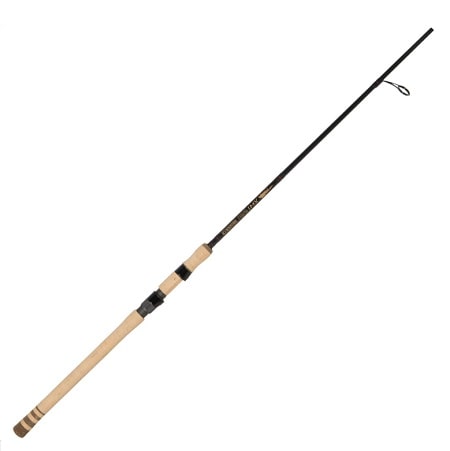
G. Loomis IMX Twitch Spinning Rod
The G. Loomis IMX Twitch Spinning Rod is actually designed for twitching jigs for salmon and steelhead in rivers.
This is a great rod for jig fishing for steelhead and salmon and my favorite rod for this method, but I also use it for casting all kinds of lures, so even though it’s a bit pricey, it’s a multi-purpose rod.
A spinning reel and rod combo make it easier on the wrists and the arm, and I feel it’s more comfortable when fishing all day, however, there are many guides and anglers that prefer a baitcasting rod and a baitcasting reel instead, so that is also a good option.
When it comes to reels, Most spinning rods in the 30 to 40 size range with a good drag and line capacity will work. See my page, 5 Best Reels For Steelhead Fishing
What Type Of Jig Heads For Steelhead
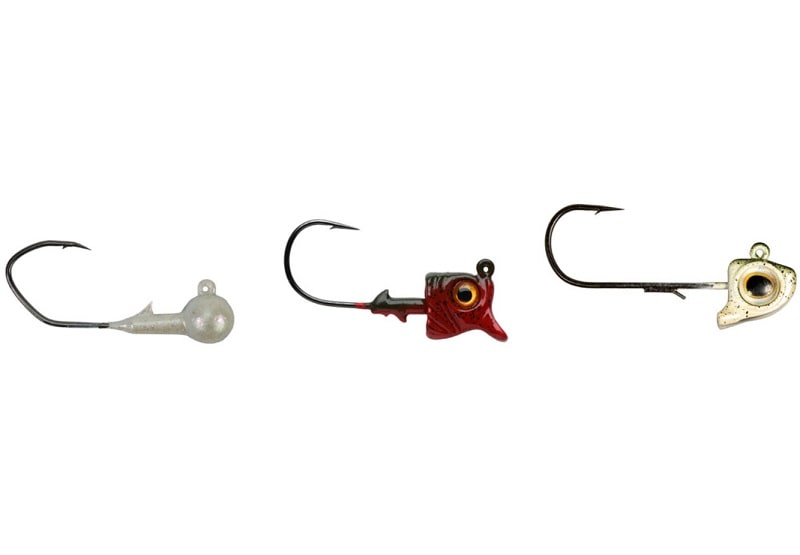
The best type of jig heads for jig fishing for steelhead with twitching jig are ones are round jig heads with a UV coating or finish or another hard paint finish. Other jig head shapes will work, too, but most guys stick with the round jig heads.
You will be banging rocks, and you want a jig head that is made with a paint finish that stays on. This is because the steelhead will often be attracted by the color of the jig head. Therefore, a beat-up, lead-grey color just may not get the attention of the steelhead as well.
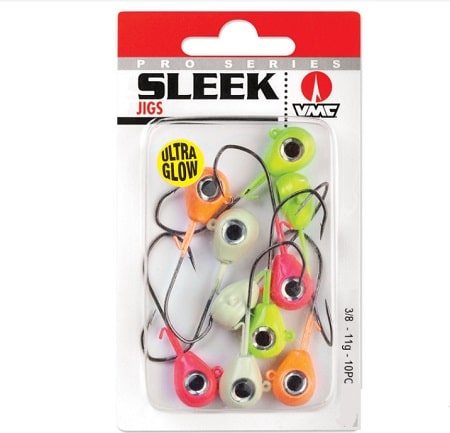
The head shape of the jig can be something you should consider. Most anglers and guides that I know use standard round jig heads for their float fishing jigs and twitching jigs.
But jig heads with eyes or fish head shaped swim jigs can be very good.
It’s a good idea to have an assortment of head shapes and colors to try. Glow jigs like the VMC Glow Sleek Jig seen above are also very popular with anglers and guides.
What Size Jig Is Best For Steelhead
There are 4 jig sizes that I use when jig fishing for steelhead if I’m using a cast and twitching method.
In general, the best jig sizes for jig fishing for steelhead are large jig heads usually weighing 1/4oz, 1/2oz, 3/4oz, or 1oz. I use the 1/4oz and 1/2oz jig heads most of the time and recommend you have a good assortment in these sizes.
Your rivers might be bigger or smaller than mine so you will need to use a jig that matches the size of the river, as well as the depth and velocity of the current, so this is what I recommend.
For small creeks like you would find around the great lakes I use a 1/4 oz jig head with a tail section that is around 2.5 to 4 inches.
For bigger rivers with heavy currents, I’ll upsize to the 1/2oz and 3/4oz jig heads with 3 to 4.5-inch tails.
When fishing very deep heavy currents on overly large rivers, I will upsize to a 1oz Jig head and have been known to go up to 5-inch tails, but generally chose 3 to 4.5-inch tails most of the time.
Best Length Of Jigs For Steelhead
Twitching Jigs: For twitching jigs, as I mentioned above, 2.5 to 4.5 inches long tails are good, but most of the time I prefer to use 3 to 4 inches tails.
Float Fishing Jigs: For float fishing jigs, you could use big jigs up to 4.5 inches long and up to 1/2 ounce, providing your float can hold them up and these big jigs might be necessary for deeper water with fast currents, but I have found that most of the time you will do well with jigs that are 2 to 3 inches long under a float in smaller sizes of 1/16, 1/8, and 1/4 ounce.
I will also use micro jigs or jig flies, that are an inch long or less, and these can be deadly in the right conditions, such as when the steelhead are less active or during the winter.
Best Colors For Jig Fishing For Steelhead
Using contrasting colors with tails that have a flash and a lot of movement is often best. This can mean having two or three colors in the tail section, or having a black or blue skirt with a pink or white grub tail. This can also mean a black jig head with a white body, or a pink jig head with a purple body and tail.
Blues, purples, blacks, and olives are often best when the water is clear, white can also be good in clear water. These more natural colors are also best when fish are nervous and pressured.
For muddier water or turbid water, or when the fish are active and aggressive, I have lots of pinks, chartreuse, reds, oranges, and glow colors. There’s something about a bright colors attractor jig that makes them bite when they are aggressive.
The brighter colors can also be seen easier in dirtier water or they stand out more when there is lots of debris coming down the river from elevated flows.
Jigs with flash can also be good, especially when the water is dirtier or turbid.
Also, be sure to change colors or color combinations if one color is not working.
One thing I tell my clients when fishing local steelhead rivers is that I will often do better fishing natural forage colors on the lower river after the fish have just come in from the lake and have been feeding on silver or white-colored baitfish. This is when I find white jigs with silver flash can be deadly good.
But, when those same fish get way up the river and have been in the river for many days or weeks, I find darker, more natural, or neutral colors can work better. This means olives, blacks, and tans, or a combination of those colors.
Steelhead Worm Jig
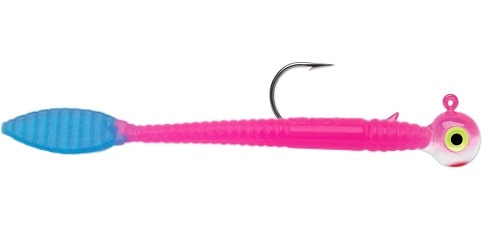
The steelhead worm jig is simply a jig head with or without marabou, a bucktail, or a rubber skirt combined with a steelhead worm like the Mad River Steelhead Paddle Tail Worms.
Basically, the steelhead worm is just part of the tail that can attract the steelhead by adding action, color, and more size to the jig.
This type of jig can work for steelhead both as a twitching jig or under a float but I have done much better with a steelhead worm jig on a small 1/16 or 1/18 jig under a float.
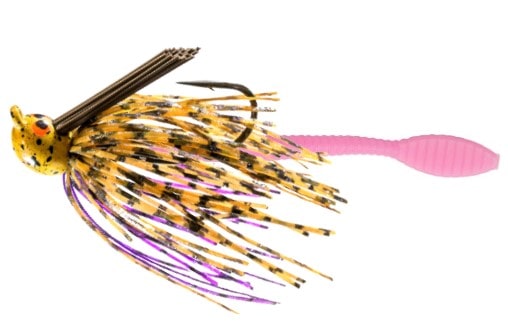
You can also add a worm to the hook of any jig with a skirt for added length, color, and attraction. The skirt can be made from marabou, bucktail, or rubber, like the one seen in the picture.
Some of the best bass jigs like the Z-Man CrossEyeZ Power Finesse Jig work well when you add a worm to it.
Jig And Maggot Steelhead
There was an article written in the field and stream back around 2007, which is when I first heard the idea of fishing jig and maggot for steelhead.
Of course, as I’ve always done after hearing a new idea like this, I tried it out multiple times over the years, and to be honest, I’m not entirely convinced.
This is how I feel about jig and maggot steelhead fishing, although tipping your jig with a maggot works probably better than a bare jig, I believe there are better options, like a worm, leech, or a minnow.
I have also found that in faster water, adding a maggot to your jig makes zero difference simply because the fish have less time to inspect the jig. In slower and almost still water, I estimate about 50% more bites with a maggot.
Some guys will add 1 maggot, but I’ve seen others add 2 to 5 to the jig hook. I’ve tried up to 3 with success but I usually only add 1 or 2.
Steelhead Jig Fishing Setup
These three steelhead Jig Fishing Setups work best for me.
The Float Steelhead Jig Fishing Setup
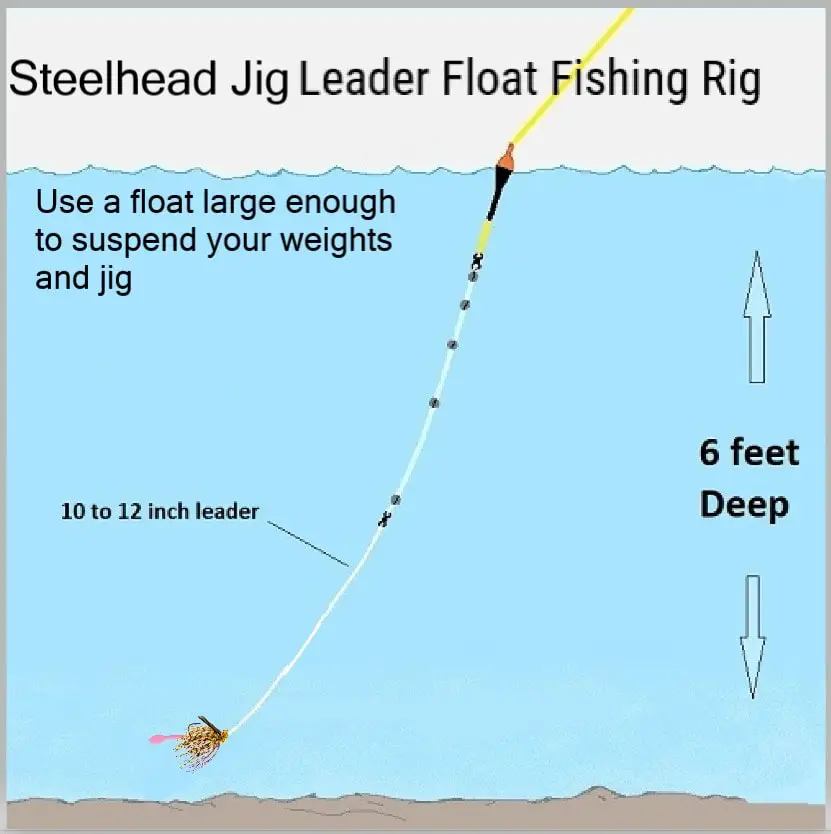
The first steelhead jig setup I use is for float fishing, and I use this the most often.
It is the same basic setup that I use when float fishing with baits.
I simply remove the bait and add small micro or lightweight jig like the Jiggy Bugger or the very popular Hawken Marabou Series AeroJig, and then I just drift it like it’s just a regular bait.
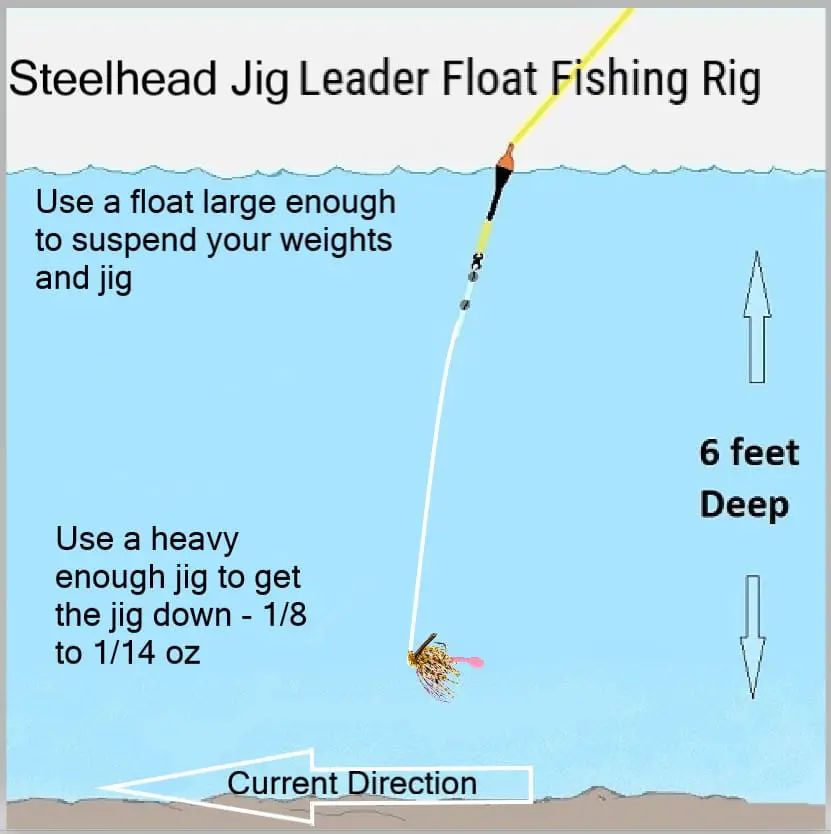
Float Fishing Jig Setup #2
Similar to the first steelhead jig setup for float fishing, this setup uses a slightly heavier jig head, so you do not require any split shots on the line.
Be sure to use a weighted jig head that is heavy enough to get the jig down, and a float big enough to suspend the jig properly.
Steelhead Jig Fishing Setup For Twitching
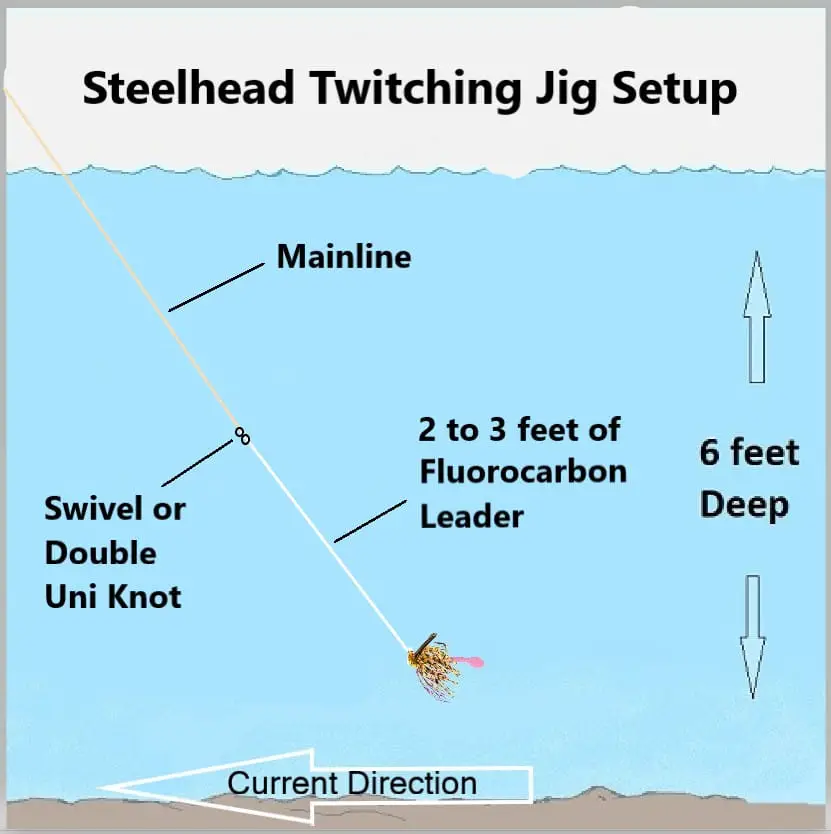
The setup I use for twitching steelhead jigs will depend on the line I’m using and the clarity of the water.
I do like using braided lines when jig fishing because of the thin diameter which gets the bait down faster and cuts through the moving current well.
Braided lines are also very sensitive and provide better hook sets due to the zero stretch.
When I use a braided line for nervous line-shy steelhead, I will add a fluorocarbon leader and set it up the way you see it in the above picture. In fact, I always use a fluorocarbon leader except when I’m fishing with fluorocarbon lines that are not too thick.
The reason for the Fluorocarbon leader is to help prevent the steelhead from seeing the line, and because fluorocarbon is very abrasion resistant, and with jig fishing, you will likely be bouncing off the rocks.
In dirtier water, or when using a fluorocarbon mainline, I will tie the line straight to the jig eye. I won’t use a leader, or a snap swivel to attach the jig.
Jig Fishing For Salmon And Steelhead
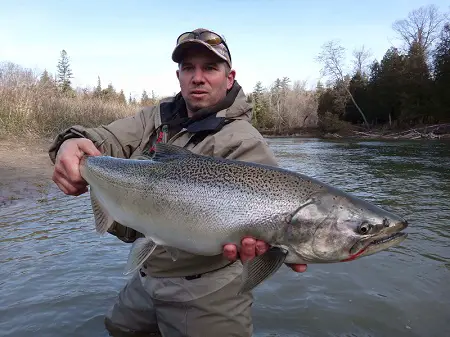
Does the jig fishing method also work for salmon once they enter the rivers?
Yes, jig fishing for salmon and steelhead is done very similarly, with the exception of using heavier lines, leaders, and rods for salmon.
Salmon will even eat the same colors and sizes of jigs, but there are a few colors and some jigs that I know work well for salmon. For more information on this, see Jig Fishing For Salmon.
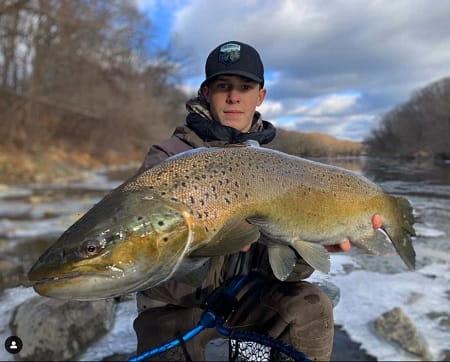
Large great lakes brown trout can be suckers for a well-presented jig. Just like the other migratory species, browns can be caught at any time of the year.
I use the same setup,the same colors, and the same methods for these giant migratory brown trout.
Maxi Jig Steelhead Jig
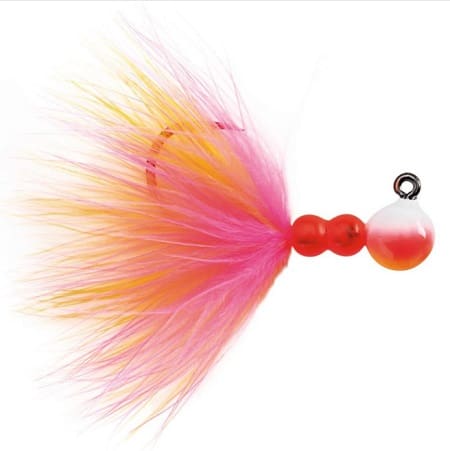
I get asked about the Worden Maxi Jig Steelhead jig and whether or not it works well.
The answer is yes; the Worden Maxi Jig Steelhead jig is a very good jig when used under a float.
The Maxi Jig Steelhead jig has good movement with the marabou tail and comes in very small sizes, and lots of colors to choose from.
Benefits of the Worden Maxi Jig Steelhead Jig:
- Used an Owner 2X super sharp jig hook
- Uses marabou for more life-like movement
- Lots of great colors to choose from
- 2-part urethane UV overcoat for more durability on the jig head
- Xtra small sizes, 1/32, 1/16, and 1/8
For these reasons, I suggest checking these out and having some on hand the next time you want to try jigs under a float.
Tight Lines,
Graham

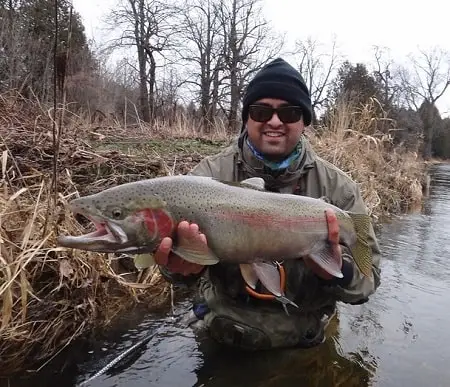
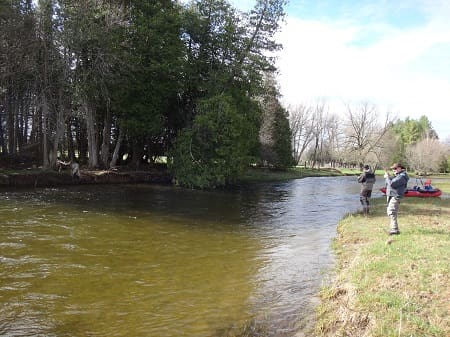
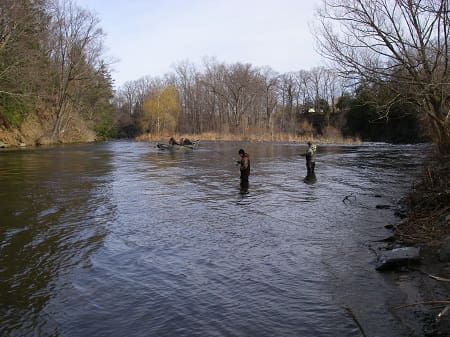
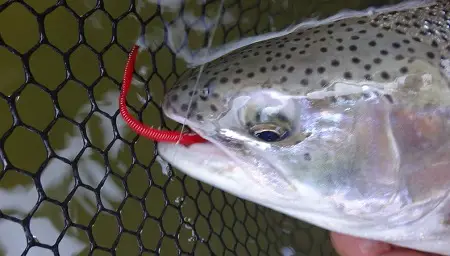
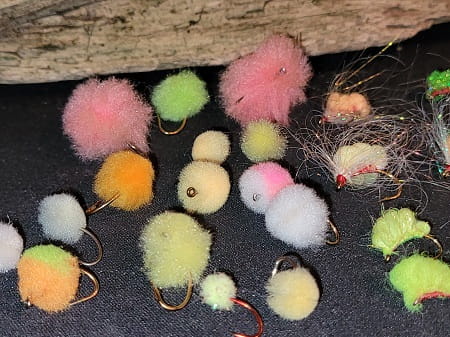
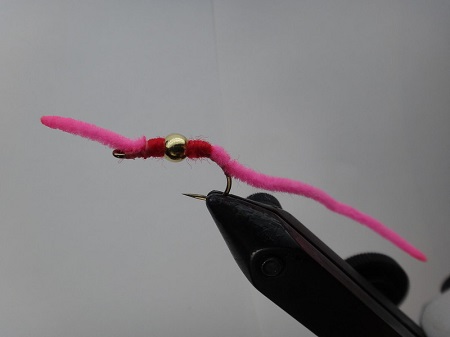
great article but it’s simpler then all this. I drift a jig I don’t twitch tip none of it depending on the drift the leader varies I use 8 pd test line a 9ft lamiglas and a tnkfish bobber it slays them. the jig is my favorite is a cop car white head black body the smaller the better. and something alot of you may be unfamiliar with its called a shad dart when the sun’s on the water they can be beat.